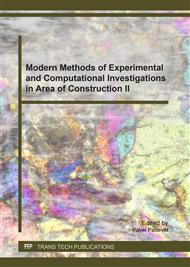p.3
p.9
p.14
p.22
p.28
p.34
p.40
p.48
Mechanical Properties of the Cement Paste with Fine Ground Recycled Concrete Depending on the Microstructure
Abstract:
This article deals with the usage of recycled concrete, which arises from the demolition of concrete structures. The work is focused on the development of mechanical properties (Young's modulus) depending on the microstructure of composite cement based materials with different percentage of fine ground recycled concrete as a partial substitute of the filler in the cement mixture, which under certain circumstances also functions as a binder component. To assess of the microstructure there were used images from the optical and scanning electron microscopy. There were used four mixtures of the cement pastes containing 0, 33, 50 and 67 wt. % of finely ground recycled concrete. Development of Young's modulus was measured by nondestructive method. The results showed that of the captured images of surfaces of individual mixtures with increasing amounts of fine ground recycled concrete is seen an increasing amount of pores, which results in a loss of cohesion of the cement matrix and decrease of the Young's modulus.
Info:
Periodical:
Pages:
22-27
Citation:
Online since:
March 2017
Authors:
Keywords:
Price:
Сopyright:
© 2017 Trans Tech Publications Ltd. All Rights Reserved
Share:
Citation:


